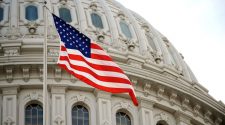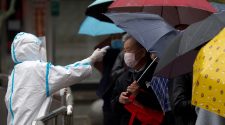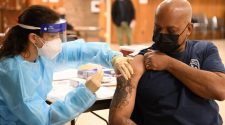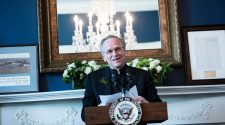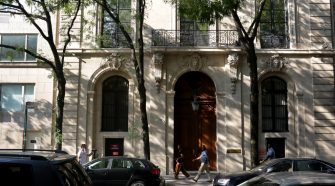Here’s what you need to know:

The nation’s health experts on Sunday pleaded with Americans to stay home over the Thanksgiving holiday and forgo any plans to travel or celebrate at large family gatherings, even as airports have recorded a significant rise in passengers.
Dr. Anthony S. Fauci, the country’s top infectious disease specialist, and other health experts relayed a clear message on Sunday morning news shows: with coronavirus cases surging to record levels across the country, turning nearly every state into a hot zone of transmission, the risk of getting infected, whether in transit or in even small indoor gatherings, is high.
Up to 50 million people could be traveling on roads and through airports in the United States over Thanksgiving this year, according to AAA, the biggest travel surge since the pandemic began, despite strong cautions from the Centers for Disease Control and Prevention and other health authorities. A video of a packed airport in Phoenix has been circulating widely on social media. As of Sunday, 47 states — all but Vermont, Maine and Hawaii — were considered high-risk zones for viral transmission, and nationwide hospitalizations were at a record 83,227.
I’m an ER doctor in Arizona and our hospitals are being overwhelmed with COVID19. 7.4 million people & only 174 ICU beds left with healthcare workers calling out sick. Our pleas for help have fallen on selfish deaf ears – this is Phoenix airport @dougduceypic.twitter.com/7iLbngxHNp
— Cleavon MD (@Cleavon_MD) November 21, 2020
“Please seriously consider decisions that you make,” Dr. Fauci said on the CBS show “Face the Nation.” Encountering large numbers of people in airports and on planes is particularly dangerous, he said. Although airlines have invested in air circulation and ventilation systems to minimize viral transmission, Dr. Fauci said, “sometimes when you get a crowded plane, or you’re in a crowded airport, you’re lining up, not everybody’s wearing masks — that puts yourself at risk.”
And gathering indoors, whether you travel or not, carries risk. “When you’re eating and drinking, obviously, you have to take your mask off,” Dr. Fauci said. “We know now that those are the kinds of situations that are leading to outbreaks.”
Dr. Tom Inglesby, director of the Center for Health Security of the Johns Hopkins Bloomberg School of Public Health, said on Fox News Sunday that because about half of infections are spread by people who don’t have any symptoms, “you can’t assume that you don’t have the virus, and you can’t assume that the people whose home you’re about to enter don’t have the virus, at this point in our pandemic.”
He recommended celebrating Thanksgiving only with the people you live with. People who choose to visit others’ homes should spend as much time as possible outdoors and “should be wearing masks indoors when they’re together, and only removing them when they’re eating.”
Dr. Fauci and others warned that Americans’ behavior over Thanksgiving will have critical implications for the coming weeks of the winter season, including risks to people gathering to celebrate Christmas and New Year’s, because the country is still months away from having wide access to vaccines and therapeutics and the cold weather drives more people indoors.
“We’re going to have to, you know, hunker down, reduce our interactions,” Dr. Scott Gottlieb, a former Trump administration Food and Drug Administration commissioner, said on Face the Nation.
As an example of the risk, he said that in a state like North Dakota, where case levels are high, there’s a 50 percent chance that someone in a group of 10 people has Covid-19. “That’s the kind of risk we’re facing individually right now,” he said. “And that’s only going to get worse.”

Parts of Staten Island are on track to have all of their nonessential businesses closed later this week and all mass gatherings banned, as the rising positivity rate for the coronavirus pushes the New York City borough into the state’s highest level of lockdown.
“Staten Island is a serious problem,” Gov. Andrew M. Cuomo said in a press briefing on Sunday. Several communities on the island, including Great Kills, Bay Terrace and Tottenville, have test positivity rates above 5 percent, roughly double the city’s average. The hospitals in the borough, the governor warned, are also becoming overburdened.
“We are running into a hospital capacity issue on Staten Island,” he said.
Mr. Cuomo said that other communities across the state were also likely to face varying levels of new restrictions this week unless they dramatically turned their situations around. But such a reversal, he warned, was unlikely given increased social activity around the holidays.
Instead of regional or statewide shutdowns, Mr. Cuomo has opted for a “micro-cluster” strategy that targets communities where positivity rates are particularly high. Areas can be given a yellow, orange or red designation, with red the most restrictive. The state already has 23 zones under various levels of restrictions.
In addition to parts of Staten Island likely becoming either red or orange zones, Mr. Cuomo said, parts of Syracuse and Rochester are on track to become orange zones. Some areas of Upper Manhattan were likely to become a yellow zone, as well as parts of Suffolk and Nassau Counties.
The area around Buffalo currently has the highest test positivity rate in the state, with some suburbs hovering at around 9 percent.
New York City and New York State both agree that a test positivity rate of 3 percent must trigger new restrictions. Indeed, Mayor Bill de Blasio closed the city’s schools when, by the city’s accounting, it hit the threshold. But the city and state use different methods to calculate the figure, leading to friction and disagreements.
On Sunday, Mr. Cuomo said that the city’s calculations were largely “irrelevant,” and that key closure decisions would be made according to his metrics. According to the state, the city currently has a seven-day average positivity rate of 2.5 percent; the city says it is 3.09 percent.

With coronavirus cases rising in every other state, Hawaii stands alone with a gradual decline in new cases in November.
Hawaii is averaging 80 cases per day on its collection of islands, a decrease of about a quarter from two weeks earlier. Hospitalizations have fallen by a similar amount.
So how has Hawaii managed to keep its caseload in check?
“Being surrounded by ocean has helped,” said Brooks Baehr, a spokesman for the Hawaii State Department of Health. “Hawaii has more control over interstate and international travel than other states.”
The recent decline in Hawaii cases has come amid an influx of several thousand more daily visitors since the authorities removed a 14-day quarantine requirement for travel to the state in mid-October. Rather than quarantining, everyone entering Hawaii must now obtain a negative test result from a verified lab in the 72 hours before arriving.
The restrictions have helped slow the travel-related rates of the coronavirus — most cases are from community spread — but they have come at a steep cost. Hawaii’s tourism industry, which accounts for 21 percent of the state’s total economy, has all but come to a standstill. In the first nine months of 2020, visitor arrivals were down 71.6 percent compared with the same period a year ago.
For residents, this meant many businesses closed and jobs lost. In the particularly fraught seven-week period between late March and early May, new unemployment claims averaged more than 30,000 per week; the same period in 2019 had a weekly average of around 1,200.
With cases exploding across the mainland and in other parts of the world, Hawaii is once again bolstering its protections.
Starting Tuesday, if an inbound air traveler’s negative test result is not available before boarding — even if that is because of a laboratory delay, as has often been the case lately — a quarantine becomes mandatory.
Also last week, Gov. David Ige issued the first statewide mask mandate, which requires everyone over age 5 to wear a face covering in public or risk penalties that include a $5,000 fine or up to a year in jail.

This month, two very different companies — the pharmaceutical giant Pfizer and the biotech upstart Moderna — reported spectacular results from high-stakes clinical trials of their experimental coronavirus vaccines. It was a remarkable feat: developing a vaccine that appears safe and effective in a matter of months, rather than the years or decades that such developments usually take.
A team of Times reporters — Sharon LaFraniere, Katie Thomas, Noah Weiland, David Gelles, Sheryl Gay Stolberg and Denise Grady — tracked how the extraordinary race unfolded, with so much at stake and such a complex backdrop. At play were not just commercial rivalries and scientific challenges but an ambitious plan to put the federal government’s Operation Warp Speed — and an often toxic political atmosphere created by President Trump — in the middle of the effort.
Pfizer’s chief executive, Dr. Albert Bourla, had vowed to avoid the political minefield but was forced to maneuver through it nonetheless. After promising a timetable that seemed to support Mr. Trump’s prediction of a breakthrough before Election Day, Dr. Bourla pushed back the schedule in late October, fearing his firm’s clinical trial results would otherwise not be convincing enough for federal regulators to grant emergency approval of its vaccine.
Dr. Bourla had chosen from the start to keep Pfizer and its research partner, the German firm BioNTech, at arms length from the government, declining research and development money from Operation Warp Speed.
But Pfizer’s main rival, Moderna, made the opposite bet, embracing the assistance of a government led by a science-denying president. Moderna got nearly $2.5 billion to develop, manufacture and sell its vaccine to the federal government and teamed up with the National Institutes of Health on the scientific work, a highly successful partnership that managed to sidestep the political meddling by Mr. Trump and his aides that had bedeviled other efforts to confront the virus.
Both companies were aided by a confluence of three factors. A new method of developing vaccines was already waiting to be tested, with the coronavirus a perfect target. Sky-high infection rates accelerated the pace of clinical trials, the most time-consuming part of the process. And the government was willing to spend whatever it took, eliminating financial risks and bureaucratic roadblocks and allowing mass production to begin even before the trials were done.
Their apparent success showed that in an era of polarized politics, science was able to break down barriers between government, countries and industry to produce one of the few pieces of good news in a year of suffering and division.

Prime Minister Boris Johnson of Britain is expected to announce a plan on Monday to return to a system of locally tailored pandemic restrictions after a broader lockdown lifts on Dec. 2, fueling frictions with lawmakers in his own party who have been feuding with him.
Under the current measures, which were imposed early this month, people throughout England may leave home only for essential reasons, including exercise and seeking medical care; most retail stores have closed, but schools and universities remain open. Before the lockdown was imposed earlier this month, the strictest rules were in place in north and northwest England, where the outbreak was worst, while less stringent limits were in effect elsewhere.
(Rules for England are set directly by the national government; in Scotland, Wales and Northern Ireland, regional parliaments are involved and somewhat different restrictions are in effect.)
Mr. Johnson’s plans for England after the lockdown include a three-tiered local system similar to but stronger than the one in place before the lockdown, the prime minister’s office said on Sunday, adding that it will include a blueprint for seeing loved ones over the December holidays. Science experts are expected to publish papers on Monday saying the pre-lockdown localized restrictions were too soft.
Mr. Johnson’s cabinet was still deliberating over the details on Sunday.
A government spokeswoman said regional restrictions would still be necessary after the lockdown lifts and before a vaccine becomes widely available; otherwise, she said, the virus could run out of control again and put intolerable pressure on the National Health Service.
But a group of around 70 lawmakers from Mr. Johnson’s Conservative Party who are worried about the economic and health impact have asked for a “full cost-benefit analysis” of the proposed regional restrictions. “The lockdown cure prescribed runs the very real risk of being worse than the disease,” the lawmakers said in a letter to the prime minister. “Restrictions should be removed immediately if it cannot be shown that they are saving more lives than they cost.”
Mr. Johnson’s plan is expected to face a vote in Parliament before the lockdown lifts. If the restive Conservative lawmakers refuse to support Mr. Johnson, he may have to rely on lawmakers from the opposition Labour Party, an awkward arrangement.
The debate comes as a second surge of infections in Britain has flattened, and officials have held out hope for some socializing around Christmas. They have already hinted that some rules, including a 10 p.m. curfew for pubs and restaurants, could be relaxed. “It’s definitely something that we’re looking at,” Rishi Sunak, Britain’s finance chief, told the BBC on Sunday.
Britain has suffered Europe’s worst toll from the pandemic, with 54,626 reported deaths as of Sunday morning and at least 1.4 million coronavirus cases in all, according to a Times database.

Whether behind the cash register, stocking milk or unloading shipments of toilet paper, grocery store employees have for months been risking their safety to earn a paycheck and make necessities available to Americans, even as the hazard pay that some companies once offered has dwindled and government benefits dry up.
But as more workers fall ill, more supermarkets may be forced to close. In New Mexico this month, health officials have ordered 23 stores and restaurants to close for two weeks because of sick workers.
Walmart, Albertsons, Target and McDonald’s stores have all been affected. Some have stayed open after being ordered to close, The Albuquerque Journal reported. And in some places, lines are growing.
“I think everybody’s a little like, ‘Oh no, we got to go get our groceries. Everything’s going to close down,’” Anna Hagele told the newspaper. She was waiting in line with about 40 other people outside of an Albertsons.
Gov. Michelle Lujan Grisham, a Democrat, defended the unpopular closures at a virtual news conference this week. Some shoppers have complained to the local news media about long lines of panicking buyers at the stores that remain open.
“You can’t have a grocery store or another big box store that sells groceries if all of their employees — or the vast majority of them — have Covid,” Ms. Lujan Grisham said. “There’s so much of this infection that it’s inside the very places need to access.”
The state is ordering shops to close for two weeks if they have four separate instances of an employee testing positive for the virus in a two-week period. At least 14 businesses are under closure orders, including some which will not be allowed to reopen until Dec. 2.
A sharp jump in virus cases in New Mexico — the number of average cases reported each day this week is up 127 percent from the week before — has led the state to issue some of the tightest restrictions of any state in recent weeks.

The French agriculture ministry said on Sunday that 1,000 minks had been slaughtered at a farm south of Paris after some of the animals tested positive, and that minks were being tested at two other farms.
France is the second European country, after Denmark, to cull farmed mink because of the virus. Unlike with other infected animals, minks have been shown to be able to transmit the virus to humans. In Denmark, mutations to the virus discovered in minks were also detected in 12 people, raising concerns about the possible spread of a version of the virus that would be less susceptible to vaccines under development.
Denmark is the world’s leading producer of minks, which are related to the weasel and raised for their fur. The Danish government’s order earlier this month to kill all 15 million to 17 million minks in the country led to a political crisis. The agriculture minister, who objected to the order, was forced to step down, but public sentiment was with him and support for the government fell sharply. Officials then halted the nationwide slaughter midway, and concentrated instead on minks in the vicinity of the outbreak.
French officials said they had seen no sign that the virus had passed from minks to humans in France. But the agriculture ministry said minks at the farm, west of Chartres, had tested positive and posed a threat.
“As soon as it learned of these results, the ministries concerned immediately ordered the slaughter of the entire population of 1,000 animals on the farm, and the destruction of all products from these animals, in order to protect public health,” the ministry said in a statement on Sunday.

The latest wave of the coronavirus has inundated Europe after a summer in which many of its countries appeared to have brought the pandemic under control more effectively than the Americas did.
The tide in Europe appears to have crested in recent days, but not before setting records that prompted another series of shutdowns and, for the first time since the spring, stretching hospitals to their limits. And the struggle there against the virus is far from over.
From late September to early November, the rate of new cases reported across the continent quintupled, to about 300,000 a day, accounting for about half the global total, before declining a bit, according to data compiled by The New York Times and the European Centre for Disease Prevention and Control. Deaths have shot up from about 700 a day to almost 5,000, and a clear pattern of receding has yet to emerge. Hospitalization numbers have begun to flatten, but at a level that is nearly as high as the spring peak.
As recently as late August, Austria and the Czech Republic each had fewer than 30 Covid-19 patients in intensive care units. Earlier this month, they reported record highs — 599 in Austria and 1,244 in the Czech Republic. Belgium had fewer than 60 Covid-19 intensive-care patients in early September; that figure peaked two months later at 1,474. Those numbers are now receding in all three countries.
When the first wave peaked in April, it was concentrated in a few western European countries, but the latest crisis has struck nearly every part of Europe, including countries that were largely spared in the spring.
While some countries are showing progress, many — including Italy, Poland, Portugal, Switzerland and Austria — are recording new cases and Covid-19 deaths faster than the United States, relative to their populations. Many others, including France, Britain, Spain, Romania and Belgium, have lower case rates but higher fatality rates.
Montenegro is leading the world with the highest daily average of cases per person, according to Times data, which shows a global top 10 of entirely European countries. Montenegro is under a two-week curfew, with citizens barred from leaving their homes from 11 p.m. to 5 a.m. except for essential work and needs.
On Friday, Patriarch Irinej, the leader of the Serbian Orthodox Church, died of Covid-19, the church confirmed, after he attended a funeral in neighboring Montenegro for the country’s senior bishop. Thousands were in attendance, many of whom are shown unmasked in a video.
Almost a third of Portugal’s total cases have come in the last two weeks, the number rising to more than 250,000 from just over 170,000 on Nov. 7.
On Saturday, Prime Minister António Costa of Portugal said the country would restrict domestic travel around two upcoming national holidays, on Dec. 1 and Dec. 8, Reuters reported. Travel between municipalities will be banned from 11 p.m. on Nov. 27 to 5 a.m. on Dec. 2, and from 11 p.m. on Dec. 4 to 5 a.m. on Dec. 9. Schools will also be closed the Mondays before both holidays, and businesses will be required to close early.
In Britain, Prime Minister Boris Johnson has continued to quarantine after coming into contact last week with a lawmaker who had tested positive for the coronavirus.
Mr. Johnson, who had the virus in March, announced on Oct. 31 that tough measures would be ordered in England, including shutting down pubs and retail shops while allowing restaurants to serve only takeout food. The measures are set to expire on Dec. 2 and will be replaced with a tiered regional system, in which each tier carries a different set of restrictions. Mr. Johnson is set to announce details of a “Covid winter plan” on Monday.
But speaking at the Group of 20 summit in Riyadh, Saudi Arabia, European leaders stressed the need for a global response to the pandemic, not one that focuses just on the needs of wealthier countries like theirs.
President Emmanuel Macron of France warned against “a two-speed world where only the richer can protect themselves against the virus and restart normal lives.”
As more countries return to shutdowns, governments are straining to find ways to support furloughed and unemployed workers, and to keep restaurants and other businesses from going bankrupt. This week, in an extraordinary move, the European Central Bank all but promised to unleash new relief measures by December at the latest.

Coronavirus cases are climbing quickly in Japan and South Korea, two countries that have managed to avoid the worst of the pandemic.
Japan has had its worst-ever jump in new cases, breaking records on four consecutive days, with at least 2,508 new cases on Sunday. Its previous worst spike dropped off after peaking at nearly 2,000 cases in early August.
On Saturday Prime Minister Yoshihide Suga announced that government-funded domestic travel stipends intended to help kick-start the economy would be suspended for some of the hardest hit areas of the country.
South Korea has had a smaller increase, with five straight days of more than 300 cases. Last week new restrictions were announced for Seoul and surrounding areas, including limiting the number of people in mass events such as concerts, conferences and festivals to 100.
South Korea was particularly hard hit at the beginning of the pandemic in February and March. On March 1 it peaked at more than 1,000 new cases. Since then the country has earned praise for bringing its outbreak under control, before enduring another surge in late August.
A South Korean health official warned that the latest surge could become the county’s worst if it is not quickly brought under control.
“We are at a crossroads as we experience a huge nationwide wave that may outclass the previous tides,” Lim Sook-young, a Korean Disease Control and Prevention Agency official, said Saturday, the Yonhap News Agency reported.
More than 500 people have died in the outbreak in South Korea this year.

